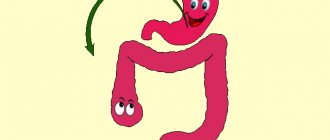You’ve eaten, it seems like you haven’t overeaten, and the food is of high quality, but your weakness increases, you feel bad, you want to hide under the covers and not see anyone? Unpleasant! What is the way out of this situation? Not eating or eating in small doses? This is not an option!
Nutrients, vitamins, and minerals enter the body with food. Refusal or reduction of portions will negatively affect your overall well-being. What to do if you feel sick after eating? No choice! You need to listen to yourself, systematize your symptoms and go to the doctor.
Digesting food is hard work for the body.
Digestion of food
It was tasty and interesting for you, but for the body the process of digesting food is hard work. Although food is crushed in the mouth, it can stick together into a dense lump in the stomach. Blood actively flows to the digestive organs, while other organs begin to experience a lack of oxygen.
Additionally, pressure in the small intestine increases, and the production of catecholamines - mediators and hormones that are involved in metabolism - is activated. This causes weakness and sometimes nausea.
A common occurrence is drowsiness after eating. This effect is associated with changes in blood glucose levels. If you have risen, we are happy, energy is in full swing and we want to live. If it has decreased, then we want to sleep or just lie idle.
Causes of nausea
Nausea can occur for a variety of reasons, ranging from gastroenteritis caused by a viral infection (a common but self-limiting condition in young children) to morning sickness in early pregnancy. Nausea can be caused by medications, overeating, or migraines. In some cases, this symptom may indicate serious and sometimes life-threatening conditions: appendicitis, kidney disease, liver disease, central nervous system disease, heart attack, brain tumor.
Other causes of nausea include:
- motion sickness in transport, including on water (kinetosis);
- benign paroxysmal positional vertigo (BPPV);
- Meniere's disease;
- food poisoning;
- rotavirus and other infections;
- coronavirus infection (COVID-19);
- ear infections;
- meningitis;
- gastroesophageal reflux disease (GERD);
- stomach ulcer;
- Crohn's disease;
- irritable bowel syndrome;
- pancreatitis;
- pancreas cancer;
- decreased activity of the muscular apparatus of the stomach (gastroparesis);
- intussusception in children;
- pyloric stenosis in infants;
- allergy to cow's milk protein;
- intestinal obstruction;
- stress, fears, generalized anxiety disorder, depression;
- anorexia, bulimia;
- vestibular neuronitis;
- alcohol abuse;
- exposure to chemicals;
- cholecystitis;
- cholelithiasis;
- acute liver failure;
- hepatitis;
- diabetic ketoacidosis;
- heart failure, heart attack;
- hyperthyroidism;
- hypoparathyroidism, hyperparathyroidism;
- intracranial hematoma;
- chemotherapy, radiation therapy.
Weakness after eating
Weakness after eating can cause hypoglycemia.
Feeling bad after lunch or dinner? This can be a symptom of various pathological conditions. Causes of discomfort:
- Hypoglycemia – a sharp drop in blood glucose
- Hyperglycemia – elevated blood glucose levels
- Dumping syndrome
- Thyroid diseases
- Pathological processes in the gastrointestinal tract - gastritis, ulcers, enteritis
All these conditions require examination, treatment and follow-up by a doctor.
Methods for treating heaviness in the head
As already mentioned, heaviness in the head in itself is not a disease. This is only a symptom, and it is the root cause of this condition that needs to be treated.
Treatment of the underlying disease is specific, selected taking into account the individual characteristics of the patient’s body and entirely depends on the identified disorders.
However, symptomatic treatment of heaviness in the head and similar accompanying symptoms is also possible. Most often, non-steroidal anti-inflammatory drugs, analgesics, antispasmodics and other drugs are used in therapy to relieve discomfort. In some cases, they resort to blockades.
However, do not forget that long-term drug treatment is addictive, and the drugs lose their effectiveness over time. So this approach to treatment can be truly justified only in a situation where heaviness in the head is caused by serious organic lesions. In other cases, it is recommended to solve the problem, if possible, through safer therapeutic methods without the use of “chemistry”.
Thus, heaviness in the head can be easily eliminated with the help of self-massage of the biologically active zones of the back of the neck, the back of the head, the temporal region, and the crown. Impact on these areas not only relieves tension from the neck muscles, but also stimulates the flow of fresh blood, which helps improve well-being and restore performance.
In addition, you should pay attention to a number of treatment methods that have proven effective in improving blood flow in the cervical spine and normalizing blood supply to the brain. First of all, these include manual therapy and all kinds of physiotherapeutic procedures.
Physical therapy exercises can also give good results in the fight against heaviness in the head, drowsiness, fatigue and other associated symptoms. Physical activity helps saturate the blood and tissues with oxygen. In addition, regular performance of even simple exercises allows you to strengthen the muscle corset and, accordingly, reduce the load on the spinal column itself and protect it from the development of destructive processes.
Hypoglycemia after eating, causes and symptoms
Diabetes mellitus can cause hypoglycemia.
Hypoglycemia is a decrease in blood glucose levels less than 3.33 mmol/l. The condition is critical and requires urgent hospitalization due to the risk of developing coma. This pathology occurs both in patients with various diseases and in completely healthy people. Causes of hypoglycemia that develops after eating:
- Rapid emptying of the stomach and intestines after surgery
- Taking galactose against the background of galactosemia is a metabolic disorder in which galactose is not transformed into glucose
- Long-term intake of fructose
- Excess leucine due to increased sensitivity to this amino acid
- Early stage of diabetes
Other types of hypoglycemia are characterized by gradual development of symptoms and do not depend on food intake. The symptoms of this pathology begin to be felt when the glucose level decreases by only 0.33 mmol/l:
Headache treatment
Doctors at the Yusupov Hospital take a comprehensive approach to the treatment of headaches, depending on the identified cause of its occurrence. In each specific case, treatment is selected individually. Therapy includes relieving headache attacks and treatment during the inter-attack period. Neurologists use the following treatment methods:
- drug therapy with the latest drugs;
- acupuncture;
- psychotherapy;
- autogenic training;
- manual therapy (to relieve muscle tension during tension headaches).
Rehabilitation clinic specialists prefer to use gentle manual techniques. The rehabilitation specialists at the Yusupov Hospital have the following innovative methods of non-drug treatment in their arsenal:
- biofeedback;
- various types of massage;
- kinesitherapy;
- physiotherapeutic treatment;
- laser therapy.
Doctors include effective medications in their headache treatment regimen. The variety of causes of headaches, which doctors at the Yusupov Hospital identify during a comprehensive examination, also determines individual approaches to the treatment of each individual patient in the neurology clinic, where there is a full arsenal of diagnostic and therapeutic assistance for headaches. If you have symptoms such as headache, nausea, weakness, make an appointment by calling the Yusupov Hospital.
Hyperglycemia after meals, symptoms
The cause of poor health after eating may be hyperglycemia.
Hyperglycemia is a condition in which there is an increase in blood levels. Doctors distinguish 2 types of this pathology:
- Hyperglycemia on an empty stomach - develops 8 hours after the last meal
- Hyperglycemia developing after eating. Blood glucose levels in this state are above 10 mmol/l
Symptoms of this pathology:
- Uncontrollable Thirst
- Defecation disorder
- Sugar is found in urine
- Weight loss
- Itching and burning of the skin
- Weakness
- In severe cases - up to coma
Important! Hyperglycemia is not a mandatory sign of diabetes. Most often this is a metabolic disorder.
Nausea is a painful sensation in the stomach and throat, which may be accompanied by weakness, increased salivation, sweating and often precedes vomiting.
Vomiting is a sudden, involuntary emptying of the stomach.
Nausea and vomiting are symptoms of many diseases and conditions, from pregnancy to such serious pathologies as brain tumors, epilepsy and myocardial infarction.
In most cases, nausea and vomiting do not pose a danger to the body. However, prolonged vomiting, often in combination with diarrhea, can lead to severe dehydration and, as a result, disruption of the cardiovascular system, brain, kidneys and other organs. This is especially true for young children who cannot control the manifestations of dehydration themselves. Pregnant women may experience so-called hyperemesis gravidarum, which disrupts the balance of electrolytes in the blood and threatens the life of the mother and fetus.
There are medications that can help reduce nausea. However, in any case, it is necessary to find out its cause.
English synonyms
Nausea, emesis, vomiting, vomitus, distaste, sickness, retching, bdelygmia.
Symptoms
The duration of nausea and vomiting, the time of their occurrence, and the effect of food intake on them depend on their underlying cause. For example, nausea and/or vomiting almost immediately after eating may indicate gastritis (inflammation of the gastric mucosa), and within 1-8 hours after eating - poisoning.
With prolonged vomiting, signs of dehydration may occur:
- dry mouth;
- thirst;
- sunken eyes;
- infrequent urination, decreased amount of urine, dark colored urine;
- In children, the fontanelle, a soft area at the junction of the child’s cranial bones, which normally closes by 12-18 months of life, may become sunken.
There are also a number of symptoms that are signs of dangerous, life-threatening conditions and require immediate medical attention:
- blood in the vomit;
- severe headache, disorientation, impaired consciousness;
- abdominal pain;
- signs of dehydration;
- dyspnea;
- vomiting that lasts longer than a day (for children - if it lasts several hours, especially in combination with diarrhea and fever).
Most often, vomiting and nausea disappear within 6-24 hours. If these symptoms recur within a week and if you suspect a possible pregnancy, you should also consult a doctor.
General information about the disease
Nausea occurs when there is a decrease or absence of gastric peristalsis with simultaneous tension of the initial part of the intestine - the duodenum, which is accompanied by the reflux of part of the contents of the duodenum into the stomach. When vomiting, there is a strong contraction of the diaphragm and muscles of the anterior abdominal wall, holding the breath and a sharp release of stomach contents into the esophagus and further into the oral cavity. This may be accompanied by increased salivation, sweating, weakness, and dizziness.
Specific centers in the brain are responsible for the occurrence of nausea and vomiting, which receive information from the gastrointestinal tract, vestibular apparatus, other parts of the brain, kidneys, and also react to the chemical composition of the blood, including toxins, medications, foods metabolism. These centers trigger and control the activity of the muscles involved in nausea and vomiting.
The causes of nausea and vomiting may be the following.
- Irritation of the gastric mucosa. In this case, nausea and vomiting are protective reactions of the body aimed at eliminating the damaging agent.
- Intestinal infections - rotavirus, salmonellosis, botulism, dysentery, etc. - in addition to nausea and vomiting, are accompanied by abdominal pain and fever. The most common infection is rotavirus. It is especially common among children attending kindergartens and nurseries, and occurs with nausea, vomiting, and diarrhea, which usually lasts 1-2 days. After the disease, immunity is formed.
- Food poisoning. In this case, vomiting occurs within several hours after eating.
- Stomach ulcer is damage to an area of the gastric mucosa under the influence of gastric juice. May be accompanied by belching, heartburn, and abdominal pain.
- Gastroesophageal reflux disease is a chronic disease in which there is a regular reflux of stomach contents into the esophagus with damage to the esophageal mucosa by acidic gastric juice.
- Irritation of the stomach by other substances: alcohol, nicotine, aspirin.
- Effects on the central nervous system and vestibular apparatus. In this case, nausea and vomiting are caused by irritation of certain centers of the brain.
- An increase in intracranial pressure due to brain injuries, tumors, infections (meningitis, encephalitis) may be accompanied by nausea and vomiting.
- Stimulation of the vestibular apparatus. Includes labyrinthitis (inflammation of the inner ear), motion sickness and other diseases and conditions in which excessive irritation of the balance organ occurs.
- Headache, particularly with migraine. Migraine is a neurological disease accompanied by severe headache, usually on one side, which can be aggravated by bright light or loud sounds and combined with nausea and vomiting.
- Sunstroke. A condition that occurs when the head is exposed to sunlight for a long time. Often found in children. May be accompanied by lethargy, weakness, nausea, vomiting, pallor, disorientation, and loss of consciousness.
- Diseases of other organs - diabetes mellitus, urolithiasis, hepatitis, pancreatitis, some malignant neoplasms, mental illnesses (depression, anorexia, bulimia) and other diseases.
- Medicines used to treat cancer, radiation therapy.
- Pregnancy (first trimester).
- In children under one year of age, vomiting can be a sign of pyloric stenosis, intussusception, and often accompanies viral diseases (influenza, ARVI). Pyloric stenosis is a narrowing or complete obstruction of the opening between the stomach and duodenum. Intussusception is a condition in which a piece of intestine becomes embedded in the lumen of an adjacent section of intestine, leading to the development of intestinal obstruction.
In adults, the most common causes of vomiting and nausea are intestinal infections, food poisoning, motion sickness in transport, in children - intestinal infections, food poisoning, overeating, as well as a severe cough and any illness with a high fever.
Who is at risk?
- Preschoolers.
- Pregnant women.
- undergoing antitumor therapy.
- People with chronic diseases of the digestive system.
- People with mental illness.
Diagnostics
When determining the cause of nausea and vomiting, their duration, time of their occurrence, and the presence of signs of other diseases and conditions are important. Laboratory and instrumental studies are also important.
Laboratory diagnostics
- General blood analysis. An elevated white blood cell count may indicate an infection as a possible cause of nausea and vomiting. An increase in the number of red blood cells indicates blood thickening due to dehydration.
- ESR. Erythrocyte sedimentation rate. Normally, red blood cells repel each other. During inflammation, the protein composition of the blood changes, electrolytes stick together more easily, and the rate of their sedimentation increases. Thus, an increase in ESR may indicate infection or chronic inflammation as a possible cause of nausea and vomiting.
- Blood electrolytes
- Serum potassium and sodium. Participate in the transmission of nerve impulses, muscle contraction, and maintaining the acid-base balance of the blood. Decreased serum potassium and sodium levels may indicate blood thickening and dehydration. Sodium levels may increase with kidney disease or adrenal dysfunction.
- Serum calcium. Calcium is involved in the formation of bone tissue, the conduction of nerve impulses, and the work of certain enzymes. A change in its level can be a sign of diseases of the kidneys, thyroid gland, parathyroid glands, and some neoplasms.
- Serum glucose. Glucose is the main source of energy in the body. An increase in its concentration is characteristic of diabetes mellitus. A significant increase in its level may indicate diabetic ketoacidosis, a severe, life-threatening condition that occurs when there is a lack of insulin. Without insulin, the body's cells cannot use glucose for energy. As a result, the body begins to use fats, the breakdown of which produces toxic substances - ketones. Thus, the level of glucose and ketones in the blood increases. Diabetic ketoacidosis can lead to coma or even death if not treated promptly.
- Total amylase in serum. This is an enzyme that is produced in the pancreas and salivary gland. Necessary for digesting carbohydrates. An increase in amylase levels may indicate a pathological process in the pancreas.
- Lipase. An enzyme that is produced in the pancreas and is involved in the digestion of fats. Elevated lipase concentration is the most specific sign of pancreatic damage.
- The β-subunit of human chorionic gonadotropin (beta-hCG) is a hormone that is produced by the membrane of the embryo and is involved in maintaining pregnancy. A beta-hCG blood test is used to diagnose pregnancy. Home pregnancy tests are also based on determining its amount in urine, but determining its level in the blood is more reliable and can detect pregnancy already on the 6-8th day after fertilization.
- General urine analysis with microscopy. Dark, concentrated urine can be a sign of dehydration.
- Sowing feces on flora. Used if an intestinal infection is suspected.
Other studies
- Ultrasound examination (ultrasound), x-ray of the abdominal organs. They are used to assess the condition of internal organs and identify the cause of nausea and vomiting.
- X-ray, computed tomography (CT), magnetic resonance imaging (MRI) of the skull. Used to diagnose injuries and brain diseases.
- Endoscopic examination of the gastrointestinal tract. This is an examination of the digestive organs using an endoscope - a special tube-shaped device equipped with an optical system. During endoscopy, a tissue sample from the wall of the digestive tract can be taken for subsequent microscopic examination.
- Lumbar puncture for suspected diseases of the central nervous system. This is taking a sample of the fluid that surrounds the spinal cord. Performed after anesthesia. For the study, a needle is used, which is inserted between the second and third or third and fourth lumbar vertebrae. At this time, the patient sits or lies on his side, with his back bent as much as possible.
- Audiometry and electronystagmography. Used to diagnose diseases of the vestibular apparatus. Audiometry is a test performed by an audiologist to determine hearing acuity. For this purpose, a special audiometer device is used. Electronystagmography is a method for recording involuntary movements of the eyeballs during head movements and temperature changes, which provides information about the state of the vestibular apparatus.
- Electroencephalography (EEG) is a study of the electrical activity of the brain using sensors placed on the head. It is carried out if a neurological or mental pathology is suspected. This is how the state of the brain and its reaction to stimuli are assessed.
Treatment
Treatment depends on the underlying cause of nausea and vomiting. There are also ways to help reduce these symptoms and prevent dehydration:
- drink slowly, in small sips;
- eat in small portions, do not mix cold and hot foods, exclude fatty, spicy, sweet, fried foods;
- do not eat during an attack of nausea;
- do not brush your teeth immediately after eating;
- Avoid physical activity immediately after eating.
In addition, there are antiemetic drugs, but they should be used only as prescribed by a doctor after the cause of the unpleasant symptoms has been established.
Prevention
- Eating only fresh, properly processed foods.
- Proper diet, especially for diseases of the gastrointestinal tract.
Recommended tests
- General blood analysis
- Erythrocyte sedimentation rate (ESR)
- Serum potassium
- Serum sodium
- Serum calcium
- Serum total amylase
- Lipase
- Serum glucose
- Beta subunit of human chorionic gonadotropin (beta-hCG)
- General urine analysis with microscopy
- Potassium in daily urine
- Calcium in daily urine
- Stool culture for pathogenic flora (disease group and typhoid-paratyphoid group)
- Cytological examination of material obtained during endoscopy (FGDS, bronchoscopy, laryngoscopy, cystoscopy, sigmoidoscopy, colonoscopy)
- Cytological examination of punctates, scrapings of other organs and tissues
Dumping syndrome
Poor condition after eating may be due to dumping syndrome.
This pathology develops after surgical interventions on the gastrointestinal tract. It consists of excessively rapid evacuation of food from the stomach to the intestines. Develops in 30% of cases as a complication after resection. The main symptoms of dumping syndrome develop either immediately after a meal or during a meal:
- Feeling of fullness in the stomach
- Weakness, decreased vision
- Pain, burning in the epigastrium
- Nausea, vomiting
- Headache
- Noise in the ears, sudden surges in pressure
- Increased gas formation
- In severe cases - up to the development of coma
The degree of severity depends on the time factor. The more time passes after the intervention, the less pronounced the symptoms become.
Identifying the causes of headaches
The causes of headaches are determined after patients at the Yusupov Hospital undergo a comprehensive neurological examination:
- ECHO - encephalography;
- electroencephalography;
- Doppler ultrasound of head and neck vessels;
- rheoencephalography;
- radiography of the skull;
- magnetic resonance and computed tomography of the brain;
- fundus examinations.
Patients receive consultation from the necessary specialists (otolaryngologist, vertebrologist, cardiologist, oncologist). If indicated, they are consulted by leading specialists from partner clinics.
How does it manifest itself?
Acute cerebrovascular accident or stroke manifests itself with severe symptoms. May be observed:
- speech disorders,
- decreased sensitivity, numbness of the limbs;
- nausea, vomiting;
- numbness of half the face, asymmetry of the tongue;
- visual impairment (“spots”, spots, loss of vision);
- coordination problems.
Chronic cerebrovascular accident develops gradually. Many people ignore the body’s signals, considering poor health to be the consequences of overwork. But a mild disorder gradually becomes a chronic disease. In this case, there will be no quick recovery: you will have to undergo a course of treatment, possibly in a hospital. Here are the signs of chronic circulatory disorders in the brain:
- weakness, drowsiness;
- difficulty concentrating;
- minor motor disturbances (unsteadiness of gait, as the disease progresses - tremors of the hands, stiffness of movements);
- dizziness.











